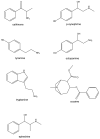Natural Sympathomimetic Drugs: From Pharmacology to Toxicology
- PMID: 36551221
- PMCID: PMC9775352
- DOI: 10.3390/biom12121793
Natural Sympathomimetic Drugs: From Pharmacology to Toxicology
Abstract
Sympathomimetic agents are a group of chemical compounds that are able to activate the sympathetic nervous system either directly via adrenergic receptors or indirectly by increasing endogenous catecholamine levels or mimicking their intracellular signaling pathways. Compounds from this group, both used therapeutically or abused, comprise endogenous catecholamines (such as adrenaline and noradrenaline), synthetic amines (e.g., isoproterenol and dobutamine), trace amines (e.g., tyramine, tryptamine, histamine and octopamine), illicit drugs (e.g., ephedrine, cathinone, and cocaine), or even caffeine and synephrine. In addition to the effects triggered by stimulation of the sympathetic system, the discovery of trace amine associated receptors (TAARs) in humans brought new insights about their sympathomimetic pharmacology and toxicology. Although synthetic sympathomimetic agents are mostly seen as toxic, natural sympathomimetic agents are considered more complacently in the terms of safety in the vision of the lay public. Here, we aim to discuss the pharmacological and mainly toxicological aspects related to sympathomimetic natural agents, in particular of trace amines, compounds derived from plants like ephedra and khat, and finally cocaine. The main purpose of this review is to give a scientific and updated view of those agents and serve as a reminder on the safety issues of natural sympathomimetic agents most used in the community.
Keywords: adrenaline; cathinone; cocaine; ephedrine; trace amines.
Conflict of interest statement
The authors declare no conflict of interest.
Figures




References
-
- Westfall T.C. Sympathomimetic Drugs and Adrenergic Receptor Antagonists. In: Squire L.R., editor. Encyclopedia of Neuroscience. Academic Press; Oxford, UK: 2009. pp. 685–695. - DOI
-
- Goldstein S., Richards J.R. Sympathomimetic Toxicity. [(accessed on 2 September 2021)]; Available online: https://www.ncbi.nlm.nih.gov/books/NBK430757/
-
- Horowitz A.J., Smith T., Frey D., Denault D. Sympathomimetics. [(accessed on 2 September 2021)]; Available online: https://www.ncbi.nlm.nih.gov/books/NBK546597/
-
- Costa V., Carvalho F., Bastos M., Carvalho R., Carvalho M., Remiao F. Adrenaline and Noradrenaline: Partners and Actors in the Same Play. In: Contreras C.M., editor. Neurochemistry. Intech Open Access Publisher; London, UK: 2012. pp. 1–14.
Publication types
MeSH terms
Substances
Grants and funding
LinkOut - more resources
Full Text Sources

